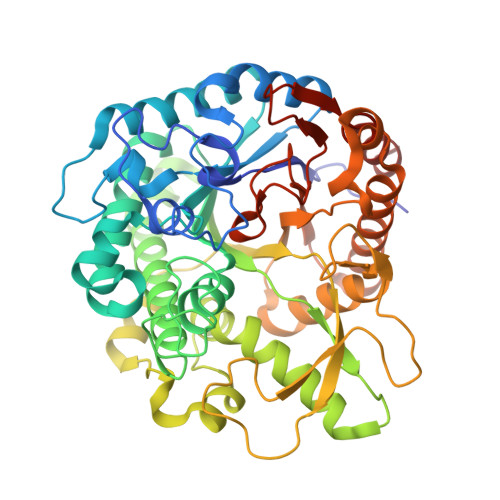Structural insights into beta-glucosidase transglycosylation based on biochemical, structural and computational analysis of two GH1 enzymes from Trichoderma harzianum.
Florindo, R.N., Souza, V.P., Mutti, H.S., Camilo, C., Manzine, L.R., Marana, S.R., Polikarpov, I., Nascimento, A.S.(2018) N Biotechnol 40: 218-227
- PubMed: 28888962
- DOI: https://doi.org/10.1016/j.nbt.2017.08.012
- Primary Citation of Related Structures:
5JBK, 5JBO - PubMed Abstract:
β-glucosidases are glycoside hydrolases able to cleave small and soluble substrates, thus producing monosaccharides. These enzymes are distributed among families GH1, GH2, GH3, GH5, GH9, GH30 and GH116, with GH1 and GH3 being the most relevant families with characterized enzymes to date. A recent transcriptomic analysis of the fungus Trichoderma harzianum, known for its increased β-glucosidase activity as compared to Trichoderma reesei, revealed two enzymes from family GH1 with high expression levels. Here we report the cloning, recombinant expression, purification and crystallization of these enzymes, ThBgl1 and ThBgl2. A close inspection of the enzymatic activity of these enzymes surprisingly revealed a marked difference between them despite the sequence similarity (53%). ThBgl1 has an increased tendency to catalyze transglycosylation reaction while ThBgl2 acts more as a hydrolyzing enzyme. Detailed comparison of their crystal structures and the analysis of the molecular dynamics simulations reveal the presence of an asparagine residue N186 in ThBgl2, which is replaced by the phenylalanine F180 in ThBgl1. This single amino acid substitution seems to be sufficient to create a polar environment that culminates with an increased availability of water molecules in ThBgl2 as compared to ThBgl1, thus conferring stronger hydrolyzing character to the former enzyme.
Organizational Affiliation:
Instituto de Física de São Carlos, Universidade de São Paulo, Av. Trabalhador Saocarlense, 400, Centro, Sao Carlos, SP 13566-590, Brazil.














